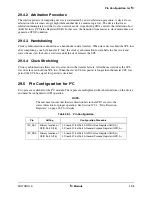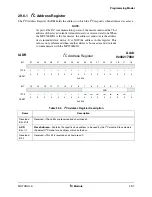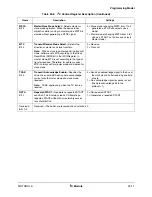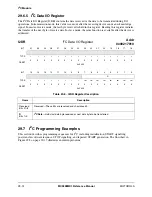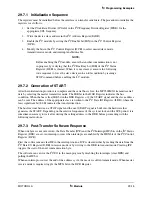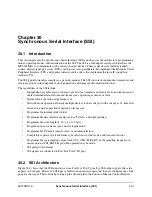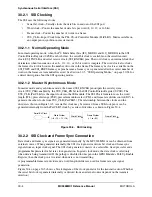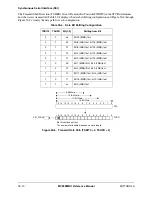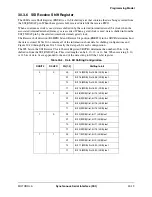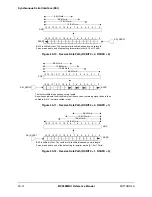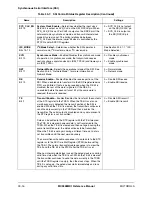
MOTOROLA
Synchronous Serial Interface (SSI)
30-1
Chapter 30
Synchronous Serial Interface (SSI)
30.1 Introduction
This section presents the Synchronous Serial Interface (SSI) and discusses the architecture, programming
model, operating modes, and initialization of the SSI. The SSI is a full-duplex serial port that allows the
MC9328MX1 to communicate with a variety of serial devices. These serial devices include standard
codecs, digital signal processors (DSPs), microprocessors, peripherals that implement the Motorola Serial
Peripheral Interface (SPI), and popular industry audio codecs that implement the inter-IC sound bus
standard (I
2
S).
The SSI typically transfers samples in a periodic manner. The SSI consists of independent transmitter and
receiver sections with independent clock generation and frame synchronization functions.
The capabilities of the SSI include:
•
Independent (asynchronous) or shared (synchronous) transmit and receive sections with separate or
shared internal/external clocks and frame syncs, operating as master or slave
•
Normal mode operation using frame sync
•
Network mode operation allowing multiple devices to share the port with as many as 32 time slots
•
Gated clock mode operation requiring no frame sync
•
Programmable internal clock divider
•
Programmable data interface modes such as I
2
S, left-, and right-justified
•
Programmable word length (8, 10, 12, or 16 bits)
•
Program options for frame sync and clock generation
•
Programmable I
2
S mode (master, slave, or normal) selection
•
Completely separate clock and frame sync selections for the receive and transmit sections
•
Programmable oversampling output clock SYS_CLK (PerCLK3) of the sampling frequency in
master mode at SSI_RXCLK pin when operated in sync mode.
•
SSI power-down feature
•
SSI signals are connected to Port B or Port C I/O pins
30.2 SSI Architecture
Figure 30-1 shows that the SSI functions can use Port B or Port C pins. For SSI output signals, the value
appears on both pins. However, SSI input or bidirectional signals require that the user configure one of the
ports for the signal. This is done by setting up the desired pin in the Function Muxing Control Register
Содержание DragonBall MC9328MX1
Страница 68: ...1 12 MC9328MX1 Reference Manual MOTOROLA Introduction ...
Страница 86: ...2 18 MC9328MX1 Reference Manual MOTOROLA Signal Descriptions and Pin Assignments ...
Страница 116: ...3 30 MC9328MX1 Reference Manual MOTOROLA Memory Map ...
Страница 126: ...4 10 MC9328MX1 Reference Manual MOTOROLA ARM920T Processor ...
Страница 160: ...8 8 MC9328MX1 Reference Manual MOTOROLA System Control ...
Страница 272: ...13 32 MC9328MX1 Reference Manual MOTOROLA DMA Controller ...
Страница 281: ...Programming Model MOTOROLA Watchdog Timer Module 14 9 ...
Страница 282: ...14 10 MC9328MX1 Reference Manual MOTOROLA Watchdog Timer Module ...
Страница 300: ...15 18 MC9328MX1 Reference Manual MOTOROLA Analog Signal Processor ASP ...
Страница 438: ...18 16 MC9328MX1 Reference Manual MOTOROLA Serial Peripheral Interface Modules SPI 1 and SPI 2 ...
Страница 478: ...19 40 MC9328MX1 Reference Manual MOTOROLA LCD Controller ...
Страница 542: ...20 64 MC9328MX1 Reference Manual MOTOROLA Multimedia Card Secure Digital Host Controller Module MMC SD ...
Страница 574: ...21 32 MC9328MX1 Reference Manual MOTOROLA Memory Stick Host Controller MSHC Module ...
Страница 598: ...23 16 MC9328MX1 Reference Manual MOTOROLA Real Time Clock RTC ...
Страница 670: ...24 72 MC9328MX1 Reference Manual MOTOROLA SDRAM Memory Controller ...
Страница 726: ...25 56 MC9328MX1 Reference Manual MOTOROLA SmartCard Interface Module SIM ...
Страница 736: ...26 10 MC9328MX1 Reference Manual MOTOROLA General Purpose Timers ...
Страница 854: ...29 18 MC9328MX1 Reference Manual MOTOROLA I2C Module ...
Страница 900: ...30 46 MC9328MX1 Reference Manual MOTOROLA Synchronous Serial Interface SSI ...
Страница 942: ...32 26 MC9328MX1 Reference Manual MOTOROLA GPIO Module and I O Multiplexer IOMUX ...

